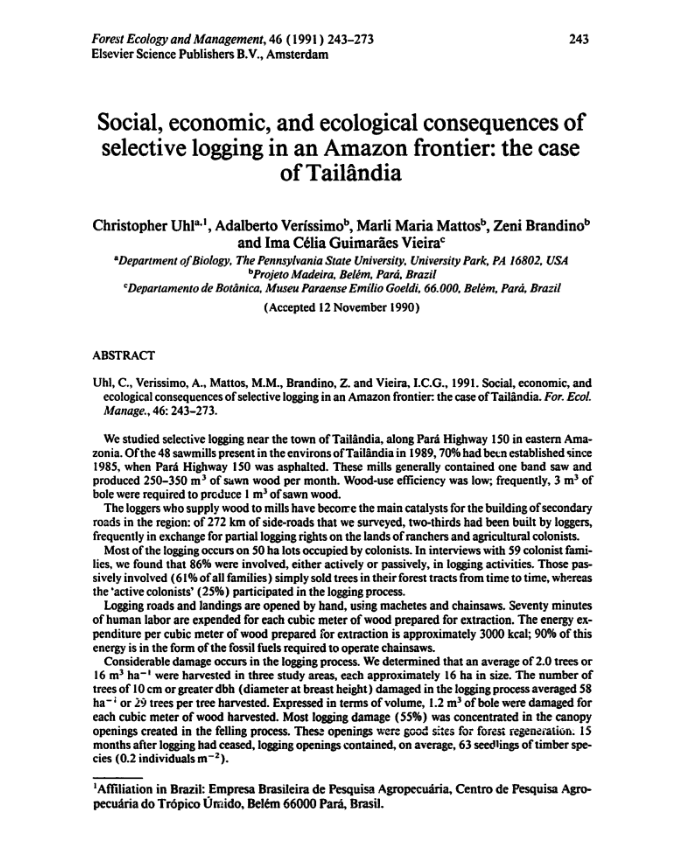

| Título | Social, economic, and ecological consequences of selective logging in an Amazon frontier: the case of Tailândia |
| Autores | Christopher Uhl (a) Adalberto Veríssimo (b) Marli Maria Mattos (b) Zeni Brandino (b) Ima Célia Guimarães Vieira (c) |
| Vinculação dos autores | (a) Department of Biology, The Pennsylvania State University, University Park, PA 16802, USA (b) Projeto Madeira, Belém, Pará, Brazil (c) Departamentoo de Botânica, Museu Paraense Emílio Goeldi, 66.000, Belém, Pará, Brazil |
| Ano de publicação | 1991 |
| Meio de publicação | Forest Ecology and Management (Volume 46, Issues 3–4, 10 December 1991, Pages 243-273) |
| DOI (Digital Object Identifier) | https://doi.org/10.1016/0378-1127(91)90235-N |
We studied selective logging near the town of Tailândia, along Pará Highway 150 in eastern Amazonia. Of the 48 sawmills present in the environs of Tailândia in 1989, 70% had been established since 1985, when Pará Highway 150 was asphalted. These mills generally contained one band saw and produced 250–350 m3 of sawn wood per month. Wood-use efficiency was low; frequently, 3 m3 of bole were required to produce 1 m3 of sawn wood.
The loggers who supply wood to mills have become the main catalysts for the building of secondary roads in the region: of 272 km of side-roads that we surveyed, two-thirds had been built by loggers, frequently in exchange for partial logging rights on the lands of ranchers and agricultural colonists.
Most of the logging occurs on 50 ha lots occupied by colonists. In interviews with 59 colonist families, we found that 86% were involved, either actively or passively, in logging activities. Those passively involved (61% of all families) simply sold trees in their forest tracts from time to time, whereas the ‘active colonists’ (25%) participated in the logging process.
Logging roads and landings are opened by hand, using machetes and chainsaws. Seventy minutes of human labor are expended for each cubic meter of wood prepared for extraction. The energy expenditure per cubic meter of wood prepared for extraction is approximately 3000 kcal; 90% of this energy is in the form of the fossil fuels required to operate chainsaws.
Considerable damage occurs in the logging process. We determined that an average of 2.0 trees or 16 m3 ha−1 were harvested in three study areas, each approximately 16 ha in size. The number of trees of 10 cm or greater dbh (diameter at breast height) damaged in the logging process averaged 58 ha−1 or 29 trees per tree harvested. Expressed in terms of volume, 1.2 m3 of bole were damaged for each cubic meter of wood harvested. Most logging damage (55%) was concentrated in the canopy openings created in the felling process. These openings were good sites for forest regeneration, 15 months after logging had ceased, logging openings contained, on average, 63 seedlings of timber species (0.2 individuals m−2).
This post was published on 10 de dezembro de 1991
Título Índice de Progresso Social Brasil 2025 Autores Melissa Wilm Daniel Santos Beto Veríssimo Marcelo…
Amorim, L., Ferreira, R., Dias, M., Souza Jr., C., & Veríssimo, A. Sistema de Alerta…
Título Fatos da Amazônia 2025 Autores Daniel Santos Manuele Lima Agatha Vilhena Beto Veríssimo Caíque…
Amorim, L., Ferreira, R., Dias, M., Souza Jr., C., & Veríssimo, A. Sistema de Alerta…
Título A Vocação da Restauração Florestal na Amazônia com Base na Vegetação Secundária Autores Jayne…
Amorim, L., Ferreira, R., Dias, M., Souza Jr., C., & Veríssimo, A. Sistema de Alerta…